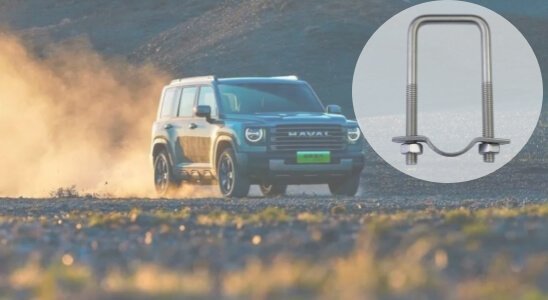Deformation Analysis Of U-shaped Bolts After Tempering,
Tempering is an important heat treatment process in bolt manufacturing, which affects the performance and shape of bolts.
For U-bolts, improper tempering treatment often leads to changes in their shape, thereby affecting their effectiveness in use.
This article will explore the possible deformation shapes and their causes of U-bolts after tempering.

1、 The deformation shape of U-shaped bolts after tempering
(1) Bending inward at both ends: This is the most common deformation shape of U-bolts after tempering.
Due to the stress and structural changes generated during the tempering process, the two ends of the bolt may bend inward,
resulting in the shape of the bolt no longer meeting the design requirements.
(2) Overall distortion: In some cases, U-bolts may experience overall distortion after tempering.
This may be due to uneven temperature distribution or uneven stress release during the tempering process.
(3) Local uplift or depression: In addition to overall deformation, U-bolts may also experience uplift or depression in certain local positions.
This may be due to local shrinkage or uneven expansion of the material during the tempering process.
2、 Analysis of deformation reasons
(1) Stress effect: During the tempering process, the internal stress of the material will change.
If the stress is not fully released or balanced, it will cause deformation of the bolt.
Especially in the early stages of tempering, the stress changes inside the material are most significant, and if not handled properly, it can easily lead to bolt deformation.
(2) Organizational changes: Tempering can cause changes in the material’s structure, thereby affecting its shape and properties.
For example, during the tempering process, carbides may precipitate or phase transitions may occur, which can cause material shrinkage or expansion, leading to bolt deformation.
(3) Improper temperature control: Tempering temperature is one of the important factors affecting bolt deformation.
If the tempering temperature is too high or too low, it will cause deformation of the bolt.
Excessive temperature can cause the material to soften excessively, making it prone to plastic deformation; A too low temperature will result in insufficient stress release of the material.
3、Methods for repairing deformed bolts
1、 Understanding the causes of deformation
Firstly, it is necessary to clarify the reasons for the deformation of U-bolts. This is usually related to factors such as temperature control,
stress release, and structural changes during the tempering process. Understanding these reasons helps to choose the appropriate repair method.
2、 Repair method
Annealing treatment
A common repair method when U-bolts deform is annealing treatment. Annealing treatment can eliminate residual stress inside the material and restore it to a lower hardness state.
Annealing treatment usually needs to be carried out at a certain temperature and time to ensure that the material can fully soften and release stress.
The specific annealing temperature and time should be determined based on the type and thickness of the material.
After annealing, U-bolts need to be corrected and fixed again to ensure that their shape and size meet the design requirements.
Mechanical correction
For some U-bolts with small deformation, mechanical correction methods can be used.
This usually requires the use of professional fixtures or tools to apply appropriate force to the bolts to restore their original shape.
Mechanical correction requires precise control of the direction and magnitude of the applied force to avoid secondary damage to the bolt.
Meanwhile, during the correction process, attention should be paid to maintaining the integrity of the bolts to avoid cracking or fracture.
Flame correction
For some U-bolts with significant deformation, flame correction can be used.
Flame correction causes plastic deformation of the material through local heating, thereby changing the shape of the bolt.
Flame correction requires strict control of heating temperature and heating area to avoid excessive heating or burning of bolts.
Meanwhile, during the correction process, attention should be paid to maintaining the uniformity and stability of heating to ensure that the bolts can deform uniformly.
After flame correction, U-bolts also need to be corrected and fixed to ensure that their shape and size meet the requirements.
Reprocessing
Deformation Analysis Of U-shaped Bolts After Tempering,If none of the above methods can repair the deformed U-bolts,
or if the bolts are severely damaged and cannot be repaired, it may be necessary to remake the bolts.
When reprocessing, appropriate materials and processes should be selected to ensure that the newly processed bolts meet the design and usage requirements.

